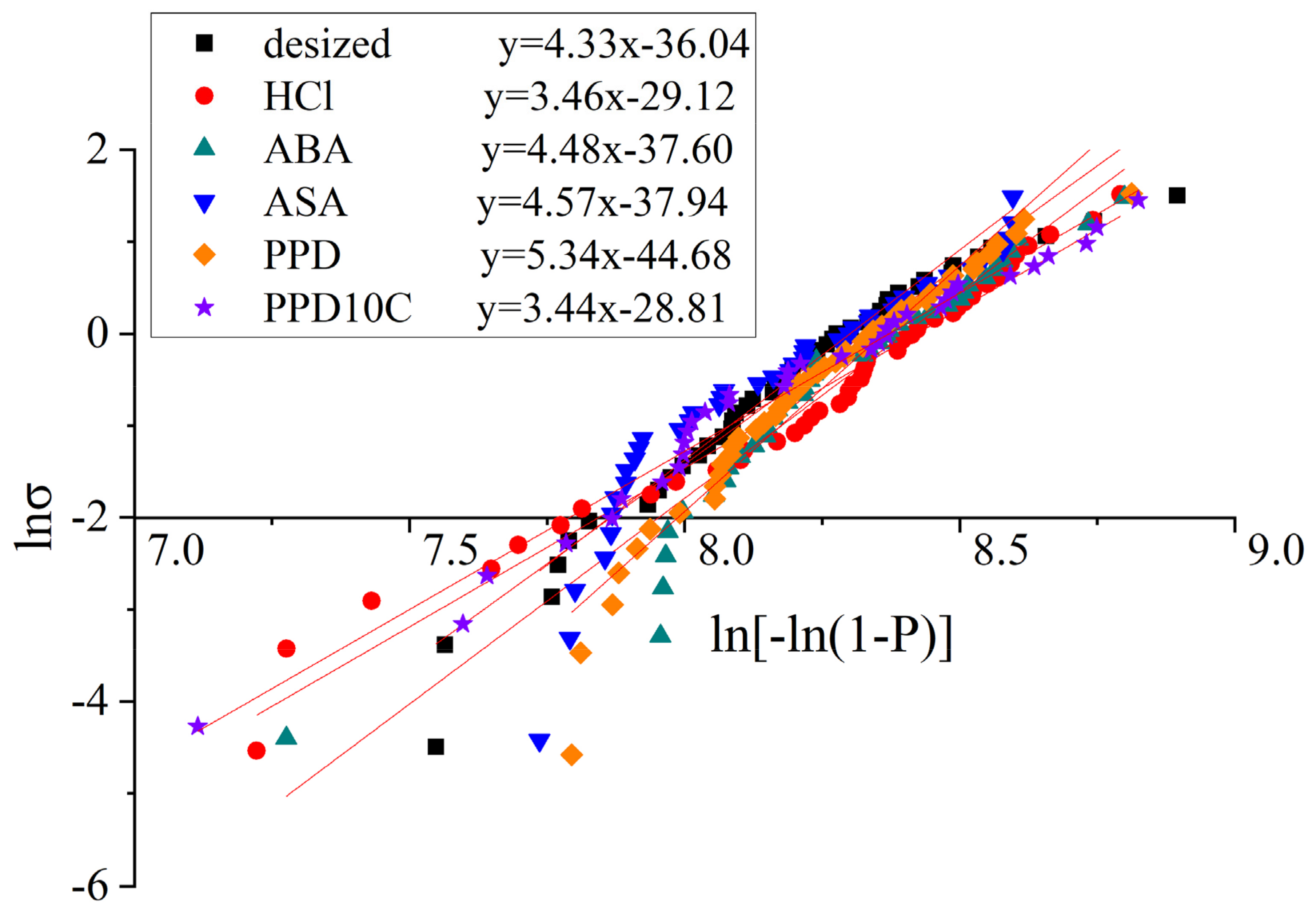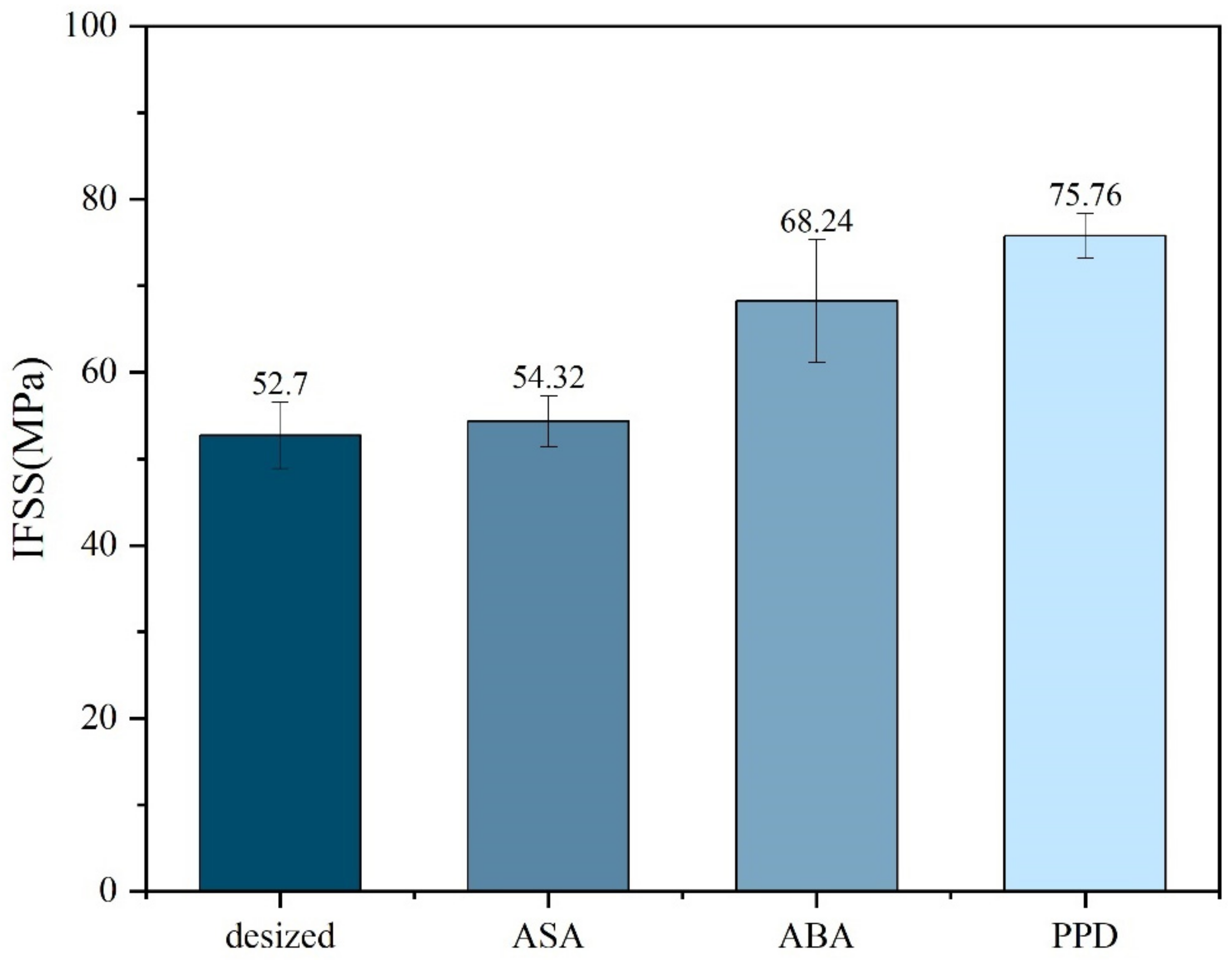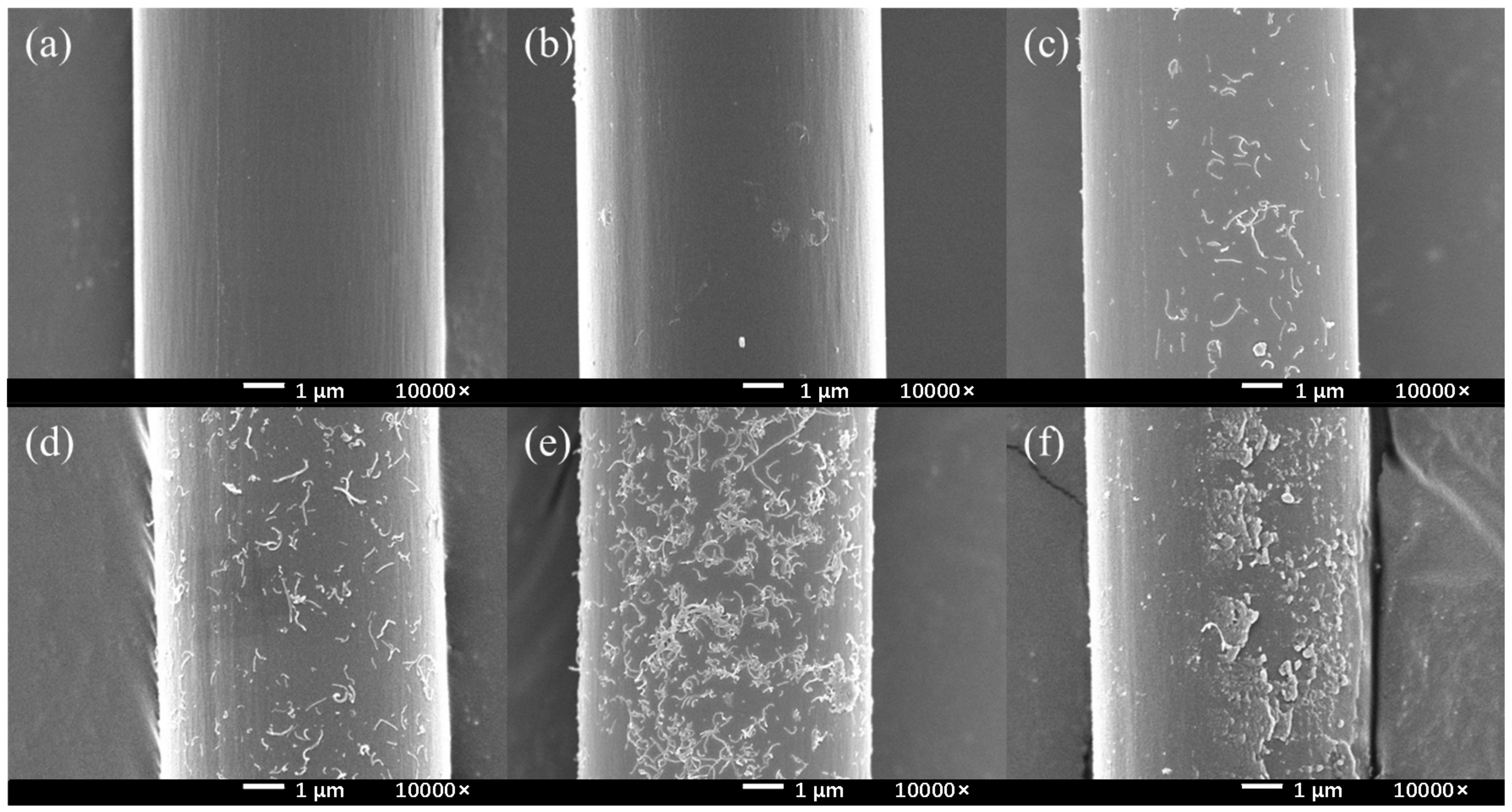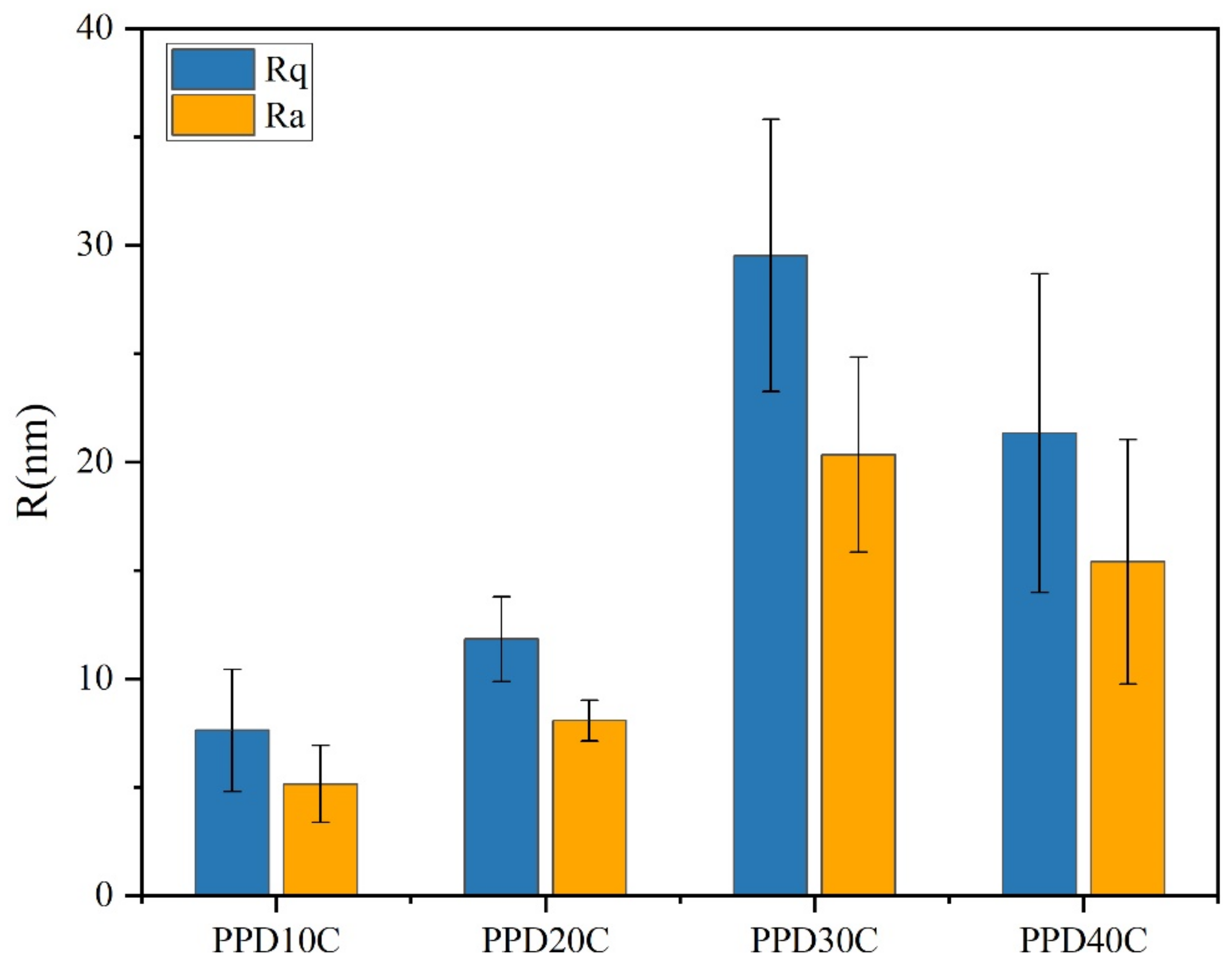Effect of Electrochemical Aryl Diazonium Salt Modification on Interfacial Properties of CF/PEEK Composites
Abstract
1. Introduction
2. Materials and Methods
2.1. Materials
2.2. Preparation
2.2.1. Preparation of Working Electrode
2.2.2. Preparation of Electrolyte Solution
2.2.3. Electrochemical Aryl Diazonium Salt Modification of CF
2.3. IFSS Test
2.4. Physicochemical Characterizations of CFs
2.5. Single Fiber Tensile Test
2.6. Contact Angle and Surface Energy
3. Results and Discussion
3.1. Effect of the Concentration on Aryl-Diazonium-Salt-Modified CF
3.2. Effect of Different Molecules on Modified CF/PEEK Interface
3.3. Effect of CNTs and Different PPD Concentration on Modified CF/PEEK Interface
4. Conclusions
Author Contributions
Funding
Institutional Review Board Statement
Informed Consent Statement
Data Availability Statement
Conflicts of Interest
References
- Korycki, A.; Carassus, F.; Tramis, O.; Garnier, C.; Djilali, T.; Chabert, F. Polyaryletherketone Based Blends: A Review. Polymers 2023, 15, 3943. [Google Scholar] [CrossRef] [PubMed]
- Hassan, E.A.M.; Elagib, T.H.H.; Memon, H.; Yu, M.; Zhu, S. Surface Modification of Carbon Fibers by Grafting PEEK-NH2 for Improving Interfacial Adhesion with Polyetheretherketone. Materials 2019, 12, 778. [Google Scholar] [CrossRef] [PubMed]
- Zhao, X.; Xiong, D.; Wu, X. Effects of Surface Oxidation Treatment of Carbon Fibers on Biotribological Properties of CF/PEEK Materials. J. Bionic Eng. 2017, 14, 640–647. [Google Scholar] [CrossRef]
- Guo, J.; Pei, W.; Dai, S.; Ma, Y.; Liu, Y.; Zhao, Y.; Ao, Y.; Liu, L.; Li, D. Synergistic enhancement of interfacial adhesion for CF/PEEK composites through carbene chemistry and water-based self-catalyzed cross-linkable PENK-NH2 sizing agent. Polym. Compos. 2024, 45, 5320–5332. [Google Scholar] [CrossRef]
- Wang, C.; He, X.; Tong, L.; Peng, Q.; Wang, R.; Li, Y.; Li, Y. Theoretical prediction and experimental verification of pulling carbon nanotubes from carbon fiber prepared by chemical grafting method. Compos. Part A 2013, 50, 1–10. [Google Scholar] [CrossRef]
- Sun, T.; Li, M.; Zhou, S.; Liang, M.; Chen, Y.; Zou, H. Multi-scale structure construction of carbon fiber surface by electrophoretic deposition and electropolymerization to enhance the interfacial strength of epoxy resin composites. Appl. Surf. Sci. 2020, 499, 143929. [Google Scholar] [CrossRef]
- Jiang, J.; Yao, X.; Xu, C.; Su, Y.; Zhou, L.; Deng, C. Influence of electrochemical oxidation of carbon fiber on the mechanical properties of carbon fiber/graphene oxide/epoxy composites. Compos. Part A 2017, 95, 248–256. [Google Scholar] [CrossRef]
- Wen, Z.; Qian, X.; Zhang, Y.; Wang, X.; Wang, W.; Song, S. Electrochemical polymerization of carbon fibers and its effect on the interfacial properties of carbon reinforced epoxy resin composites. Compos. Part A 2019, 119, 21–29. [Google Scholar] [CrossRef]
- Li, Y.; Xu, N.; Lyu, H.; Jiang, N.; Zhang, H.; Zhou, N.; Zhang, D. Enhanced mechanical and tribological properties of carbon fiber/PEEK composites by hydroxylated boron nitride nanosheets and polyetherimide sizing agents. Compos. Sci. Technol. 2023, 232, 109851. [Google Scholar] [CrossRef]
- Li, Y.; Jiang, N.; Xu, N.; Zhang, H.; Zhou, N.; Zou, X.; Zhang, Y.; Zhang, D. A facile strategy to prepare boron nitride grafted carbon nanotubes coating for CF/ PEEK composites interfacial enhancement. Compos. Commun. 2023, 44, 101770. [Google Scholar] [CrossRef]
- Zhou, N.; Jia, J.; Zhao, S.; Zhang, D.; Feng, M. Interfacial enhancement of CF/PEEK composites by coating sulfonated PEEK sizing agent. Surf. Interfaces 2023, 37, 102652. [Google Scholar] [CrossRef]
- Wang, S.; Wang, T.; Zhang, S.; Dong, Z.; Chevali, V.S.; Yang, Y.; Wang, G.; Wang, H. Enhancing fiber-matrix interface in carbon fiber/poly ether ether ketone (CF/PEEK) composites by carbon nanotube reinforcement of crystalline PEEK sizing. Compos. Part B 2023, 251, 110470. [Google Scholar] [CrossRef]
- Yildirim, C.; Ulus, H.; Beylergil, B.; Al-Nadhari, A.; Topal, S.; Yildiz, M. Tailoring adherend surfaces for enhanced bonding in CF/PEKK composites: Comparative analysis of atmospheric plasma activation and conventional treatments. Compos. Part A 2024, 180, 108101. [Google Scholar] [CrossRef]
- Fu, Y.; Li, H.; Cao, W. Enhancing the interfacial properties of high-modulus carbon fiber reinforced polymer matrix composites via electrochemical surface oxidation and grafting. Compos. Part A 2020, 130, 105719. [Google Scholar] [CrossRef]
- Yan, F.; Yan, T.; Wang, G.; Li, G.; Dai, S.; Ao, Y.; Duan, J.; Liu, L. A novel thermoplastic water-soluble sizing agent for the interfacial enhancement of carbon fiber/polyether ether ketone composites. Compos. Part B 2024, 272, 111205. [Google Scholar] [CrossRef]
- Beggs, K.M.; Servinis, L.; Gengenbach, T.R.; Huson, M.G.; Fox, B.L.; Henderson, L.C. A systematic study of carbon fibre surface grafting via in situ diazonium generation for improved interfacial shear strength in epoxy matrix composites. Compos. Sci. Technol. 2015, 118, 31–38. [Google Scholar] [CrossRef]
- Delamar, M.; Dbsarmot, G.; Fagebaume, O.; Hitmi, R.; Pinson, J.; Saveant, M. Modification Of Carbon Fiber Surfaces By Electrochemical Reduction Of Aryl Diazonium Salts: Application To Carbon Epoxy Composites. Carbon 1997, 35, 801–807. [Google Scholar] [CrossRef]
- Cougnon, C.; Nguyen, N.H.; Dabos-Seignon, S.; Mauzeroll, J.; Bélanger, D. Carbon surface derivatization by electrochemical reduction of a diazonium salt in situ produced from the nitro precursor. J. Electroanal. Chem. 2011, 661, 13–19. [Google Scholar] [CrossRef]
- Servinis, L.; Beggs, K.M.; Scheffler, C.; Wölfel, E.; Randall, J.D.; Gengenbach, T.R.; Demir, B.; Walsh, T.R.; Doeven, E.H.; Francis, P.S.; et al. Electrochemical surface modification of carbon fibres by grafting of amine, carboxylic and lipophilic amide groups. Carbon 2017, 118, 393–403. [Google Scholar] [CrossRef]
- Servinis, L.; Henderson, L.C.; Andrighetto, L.M.; Huson, M.G.; Gengenbach, T.R.; Fox, B.L. A novel approach to functionalise pristine unsized carbon fibre using in situ generated diazonium species to enhance interfacial shear strength. J. Mater. Chem. A 2015, 3, 3360–3371. [Google Scholar] [CrossRef]
- Eyckens, D.J.; Arnold, C.L.; Randall, J.D.; Stojcevski, F.; Hendlmeier, A.; Stanfield, M.K.; Pinson, J.; Gengenbach, T.R.; Alexander, R.; Soulsby, L.C.; et al. Fiber with Butterfly Wings: Creating Colored Carbon Fibers with Increased Strength, Adhesion, and Reversible Malleability. ACS Appl. Mater. Interfaces 2019, 11, 41617–41625. [Google Scholar] [CrossRef] [PubMed]
- Andideh, M.; Esfandeh, M. Effect of surface modification of electrochemically oxidized carbon fibers by grafting hydroxyl and amine functionalized hyperbranched polyurethanes on interlaminar shear strength of epoxy composites. Carbon 2017, 123, 233–242. [Google Scholar] [CrossRef]
- Han, S.; Yuan, Y.; Hu, L.; Xu, G. Electrochemical derivatization of carbon surface by reduction of diazonium salts in situ generated from nitro precursors in aqueous solutions and electrocatalytic ability of the modified electrode toward hydrogen peroxide. Electrochem. Commun. 2010, 12, 1746–1748. [Google Scholar] [CrossRef]
- Seck, S.M.; Charvet, S.; Fall, M.; Baudrin, E.; Geneste, F.; Lejeune, M.; Benlahsen, M. Functionalization of amorphous nitrogenated carbon thin film electrodes for improved detection of cadmium vs. copper cations. J. Electroanal. Chem. 2015, 738, 154–161. [Google Scholar] [CrossRef]
- Pinson, J.; Podvorica, F. Attachment of organic layers to conductive or semiconductive surfaces by reduction of diazonium salts. Chem. Soc. Rev. 2005, 34, 429–439. [Google Scholar] [CrossRef]
- Oweis, Y.; Alageel, O.; Kozak, P.; Abdallah, M.-N.; Retrouvey, J.-M.; Cerruti, M.; Tamimi, F. Metal-composite adhesion based on diazonium chemistry. Dent. Mater. 2017, 33, e393–e404. [Google Scholar] [CrossRef] [PubMed]
- Liu, Y.-T.; Wu, G.-P.; Lu, C.-X. Grafting of carbon nanotubes onto carbon fiber surfaces by step-wise reduction of in-situ generated diazonium salts for enhancing carbon/epoxy interfaces. Mater. Lett. 2014, 134, 75–79. [Google Scholar] [CrossRef]
- American Society for Testing and Materials. Testing Method for Strength and Young’s Modulus of High Modulus Monofilament Tensile Materials. 1975. Available online: https://softbank.iust.ac.ir/Railway/Codes/ASTM-standard/ASTM_2004_Standards/ASTM%202004%20PART%20III/ASTM%202004%20Volume%2015.01%20Refractories,%20Activated%20Carbon_%20Advanced%20Ceramics/D%203379%20-%2075%20R89%20%20_RDMZNZK_.pdf (accessed on 27 May 2024).
- Liu, H.; Sun, J.; Zhang, L.; Liu, Z.; Huang, C.; Sun, M.; Duan, Z.; Wang, W.; Zhong, X.; Bao, J. Influence of the Second-Phase Resin Structure on the Interfacial Shear Strength of Carbon Fiber/Epoxy Resin. Materials 2024, 17, 1323. [Google Scholar] [CrossRef]
- Li, N.; Zong, L.; Wu, Z.; Liu, C.; Wang, X.; Bao, F.; Wang, J.; Jian, X. Amino-terminated nitrogen-rich layer to improve the interlaminar shear strength between carbon fiber and a thermoplastic matrix. Compos. Part A 2017, 101, 490–499. [Google Scholar] [CrossRef]










| Liquid | (mJ·m−2) | (mJ·m−2) | (mJ·m−2) |
|---|---|---|---|
| water | 72.80 | 51.00 | 21.80 |
| ethylene glycol | 47.70 | 16.80 | 30.90 |
| Atomic (%) | ||||
|---|---|---|---|---|
| C 1s | O 1s | N 1s | S 2p | |
| HCl | 82.51 | 15.46 | 1.92 | 0.11 |
| ABA | 81.57 | 16.29 | 2.02 | 0.12 |
| ASA | 79.06 | 17.33 | 2.54 | 1.07 |
| PPD | 80.48 | 16.11 | 3.20 | 0.21 |
| Sample Name | m | ||
|---|---|---|---|
| desized | 4.33 | 4139.19 | 3768.75 |
| HCl | 3.46 | 4547.45 | 4088.90 |
| ABA | 4.48 | 4445.86 | 4055.95 |
| ASA | 4.57 | 4027.12 | 3678.38 |
| PPD | 5.34 | 4281.28 | 3945.97 |
| PPD10C | 3.44 | 4323.51 | 3886.60 |
| Sample Name | n | SE, A | SE, B | Dn | D(n,0.05) |
|---|---|---|---|---|---|
| desized | 45 | 0.1501 | 1.2348 | 0.0941 | 0.2027 |
| HCl | 47 | 0.0860 | 0.7107 | 0.0984 | 0.1984 |
| ABA | 41 | 0.1880 | 1.5562 | 0.1501 | 0.2124 |
| ASA | 42 | 0.2602 | 2.1280 | 0.1323 | 0.2099 |
| PPD | 49 | 0.1976 | 1.6315 | 0.0925 | 0.1943 |
| PPD10C | 40 | 0.0881 | 0.7251 | 0.1084 | 0.2150 |
| Sample | θ Water (°) | θ Ethylene Glycol (°) | (mJ·m−2) | (mJ·m−2) | (mJ·m−2) |
|---|---|---|---|---|---|
| PPD10C | 87.67 | 63.26 | 5.70 | 19.89 | 25.59 |
| PPD20C | 82.10 | 60.93 | 9.90 | 16.45 | 26.35 |
| PPD30C | 79.49 | 58.04 | 11.25 | 16.72 | 27.97 |
| PPD40C | 62.59 | 45.62 | 26.70 | 12.12 | 38.82 |
Disclaimer/Publisher’s Note: The statements, opinions and data contained in all publications are solely those of the individual author(s) and contributor(s) and not of MDPI and/or the editor(s). MDPI and/or the editor(s) disclaim responsibility for any injury to people or property resulting from any ideas, methods, instructions or products referred to in the content. |
© 2024 by the authors. Licensee MDPI, Basel, Switzerland. This article is an open access article distributed under the terms and conditions of the Creative Commons Attribution (CC BY) license (https://creativecommons.org/licenses/by/4.0/).
Share and Cite
Sun, M.; Li, X.; Liu, H.; Huang, C.; Wang, K.; Zhao, Y. Effect of Electrochemical Aryl Diazonium Salt Modification on Interfacial Properties of CF/PEEK Composites. Materials 2024, 17, 2899. https://doi.org/10.3390/ma17122899
Sun M, Li X, Liu H, Huang C, Wang K, Zhao Y. Effect of Electrochemical Aryl Diazonium Salt Modification on Interfacial Properties of CF/PEEK Composites. Materials. 2024; 17(12):2899. https://doi.org/10.3390/ma17122899
Chicago/Turabian StyleSun, Mingchen, Xuekuan Li, Hansong Liu, Chengyu Huang, Kai Wang, and Yan Zhao. 2024. "Effect of Electrochemical Aryl Diazonium Salt Modification on Interfacial Properties of CF/PEEK Composites" Materials 17, no. 12: 2899. https://doi.org/10.3390/ma17122899
APA StyleSun, M., Li, X., Liu, H., Huang, C., Wang, K., & Zhao, Y. (2024). Effect of Electrochemical Aryl Diazonium Salt Modification on Interfacial Properties of CF/PEEK Composites. Materials, 17(12), 2899. https://doi.org/10.3390/ma17122899






